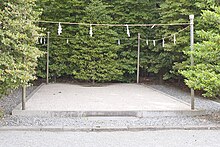User:Ansei/Sandbox-Oki
| This is a Wikipedia user page. This is not a Wikipedia article or the talk page for a Wikipedia article. If you find this page on any website other than Wikipedia, you are looking at a mirror site. This page may not be up to date, and the user who made this page may have no relationship with any site other than Wikipedia. The original page can be found at https://simple.wikipedia.org/wiki/User:Ansei/Sandbox-Oki. |
This page has been removed from search engines' indexes.

Oki islands[change | change source]
Hokkaido[change | change source]
National parks and quasi-national parks[change | change source]
Hokkaido contains some of the oldest and largest national parks in Japan. They cover large areas of some of the most pristine nature in Japan, including mountainous and maritime environments. The six parks are home to rich biodiversity, complemented by volcanic and thermal activities.[1]
| National parks (国立公園) | |
|---|---|
| Shiretoko National Park (知床) is a 65km peninsula jutting out into the Sea of Okhotsk that was designated by UNESCO as a World Natural Heritage site on 2005-07-14. Features a hot spring waterfall (Kamuiwakka) and a large population of brown bears. The winter is known for drifting sea ice that brings thousands of Steller's Sea Eagles. | |
| Akan National Park (阿寒) one of the first national parks to be designated in Japan (1934), Akan is home to the caldera lakes of Akan, Kussharo and Mashu, flanked by two active volcanoes. These crystal clear lakes are famous for the rare and unusual type of spherical green algae that grow there - 'Marimo' balls as big as 30cm in diameter can be found, making them the largest in the world. | |
| Kushiro Shitsugen National Park (釧路湿原) is a Ramsar designated wild bird sanctuary. This wetlands area is home to many designated Natural Treasures, including Blakiston's Fish-Owl, Whooper Swans and the majestic Red-Crowned Cranes, known for their elaborate mating dance. | |
| Daisetsuzan National Park (大雪山) is the largest national park in Japan, covering 2309 sq km (93% of which is state-owned). Among the first national parks to be designated in1934, this huge area at the heart of Hokkaido is home to a diversity of mountains and volcanoes, rivers and steep gorges, waterfalls and lakes. As well as old-growth woodland and abundant wildlife, hot springs and ski areas can also be found here. | |
| Shikotsu-Toya National Park (支笏洞爺) is Hokkaido’s second largest National Park covering an area of some 1000 sq km. It is centred around two large lakes, Shikotsu and Toya, and also contains many hot springs due to the active volcano belt in this Geopark. Located near to Sapporo, the easy access ensures a range of well-developed sightseeing spots. | |
| Rishiri-Rebun-Sarobetsu National Park (利尻礼文サロベツ) consists of a stretch of coastline and two islands off the north coast of Hokkaido. Mt Rishiri Fuji (1,721m) is a mini version of Mt Fuji that makes a popular goal for climbers. Rebun Island is known as the land of flowers as hundreds of species of alpine plants bloom here in spring and summer. | |
| Quasi-national parks (国定公園) | |
|---|---|
| Abashiri Quasi-National Park | 網走 |
| Hidaka Sanmyaku-Erimo Quasi-National Park | 日高山脈襟裳 |
| Niseko-Shakotan-Otaru Kaigan Quasi-National Park | ニセコ積丹小樽海岸 |
| Ōnuma Quasi-National Park | 大沼 |
| Shokanbetsu-Teuri-Yagishiri Quasi-National Park | 暑寒別天売焼尻 |
- Twelve prefectural natural parks (道立自然公園). The prefectural natural parks cover 146,802 ha, the largest area of any prefecture.[2]
- Akkeshi Prefectural Natural Park
- Furano-Ashibetsu Prefectural Natural Park
- Hiyama Prefectural Natural Park
- Kariba-Motta Prefectural Natural Park
- Matsumae-Yagoshi Prefectural Natural Park
- North Okhotsk Prefectural Natural Park
- Nopporo Shinrin Kōen Prefectural Natural Park
- Notsuke-Fūren Prefectural Natural Park
- Sharidake Prefectural Natural Park
- Shumarinai Prefectural Natural Park
- Teshiodake Prefectural Natural Park
| Ramsar wetland sites | ||
|---|---|---|
| since | ||
| Kushiro Wetland | ja:釧路湿原 | 1980-06-17 |
| Lake Kutcharo | ja:クッチャロ湖 | 1989-07-06 |
| Lake Utonai | ja:ウトナイ湖 | 1991-12-12 |
| Kiritappu Wetland | ja:霧多布湿原 | 1993-06-10 |
| Lake Akkeshi, Bekkanbeushi Wetland | ja:厚岸湖・別寒辺牛湿原 | 1993-06-10, enlarged 2005-11-08 |
| Miyajima Marsh | ja:宮島沼 | 2002-11-18 |
| Uryūnuma Wetland | ja:雨竜沼湿原 | 2005-11-08 |
| Sarobetsu plain | ja:サロベツ原野 | |
| Lake Tōfutsu | ja:濤沸湖 | |
| Lake Akan | ja:阿寒湖 | |
| Notsuke Peninsula, Notsuke Bay | ja:野付半島・ja:野付湾 | |
| Lake Fūren, Shunkunitai | ja:風蓮湖・ja:春国岱 | |
- ↑ http://www.hokkaidonationalparks.com
- ↑ "General overview of area figures for Natural Parks by prefecture" (PDF). Ministry of the Environment Japan. 31 March 2008. Retrieved 2009-06-02.
